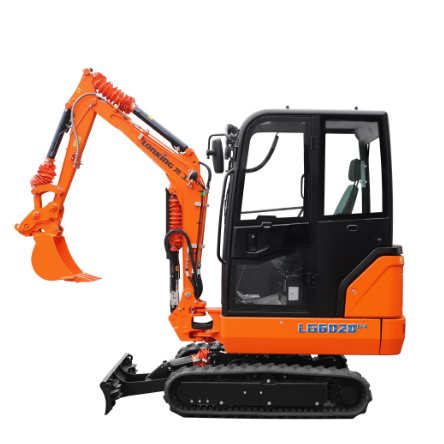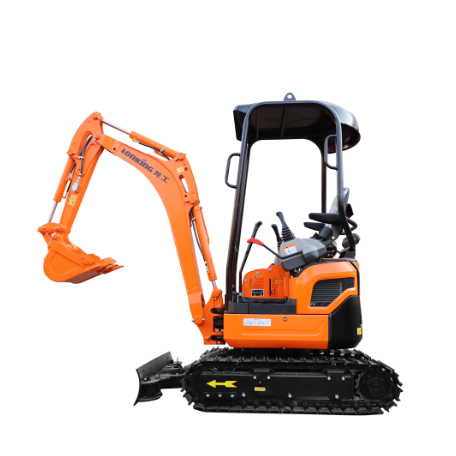Ოპერატორის და სამუშაო ადგილის უსაფრთხოების უზრუნველყოფა ექსკავატორის გამოყენებისას
Სამშენებლო ინდუსტრია საუკეთესოდ ეყრდნობა ძალას და მრავალფეროვნებას სათხრელი მანქანები შესასრულებლად ამოცანების, როგორიცაა მოთხოვნა, აწევა და დაშლა. ეს მძიმე ტექნიკა გახდა გამოუყენებელი სამუშაო ადგილებზე მათი შესაძლებლობის გასაუმჯობესებლად და ხელით შრომის შესამსუბუქებლად. თუმცა, ექსკავატორების სირთულე და ძალა ასევე წარმოადგენს მნიშვნელოვან უსაფრთხოების რისკებს, თუ ისინი არ იქნება სწორად მოვლილი. ახალგაზრდა და გამოცდილი ოპერატორებისთვის საჭიროა მკაცრად ე adher უსაფრთხოების პროტოკოლებს დაზიანების თავიდან ასაცილებლად და ეფექტურობის შესანარჩუნებლად.
Ექსკავატორთან დაკავშირებული საფრთხეების გაგება
Მოწყობილობების გაუმართაობა და მექანიკური გამართულება
Შეუძლებელია ავარიების ერთ-ერთი ძირითადი მიზეზი სათხრელი მანქანები მექანიკური გაუმართაობაა. დაზიანებული დამუხრუჭები, ჰიდრავლიკური გაჟონვები და დახმარებული ნაწილები ყველა წვდომს აქვს არასასურველ გაუმართაობას. პროფილაქტიკური შემოწმებებისა და მუდმივი მომსახურების განრიგის ჩატარება უზრუნველყოფს გამოყენებული მანქანების საიმედო ექსპლუატაციას და შეამცირებს სამუშაო ადგილზე დაზიანების რისკს, რაც შეიძლება გამოწვეული იყოს გამართულებით.
Სამშენებლო ადგილის გარემოს სპეციფიკური რისკები
Სამშენებლო ადგილები მნიშვნელოვნად განსხვავდება და თითოეული ადგილი უნიკალურ გამოწვევებს უხდის სახელს. არათანაბარი მიწა, მარილიანი ნიადაგი და ახლომდებარე სტრუქტურები ამატებს არსებითად დაბრუნების ან არასასურველი ზიანის შესაძლებლობას. მუშაობის დაწყებამდე ადგილის შეფასება საშუალებას აძლევს გუნდებს შეასწორონ გათხრის გეგმები და აირჩიონ სამუშაოსთვის საჭირო გათხრის მანქანა.
Უსაფრთხოების ზომები მუშაობის დაწყებამდე
Ყოველდღიური მანქანების შემოწმება
Ნებისმიერი ამოცანის დაწყებამდე ოპერატორებმა უნდა მოახდინონ ექსკავატორის სრული ინსპექცია. ეს გულისხმობს ზიანის არსებობის შემოწმებას, ჰიდრავლიკური სისტემების შემოწმებას, სწორი გულაბის ან ქვედა სარბენი მოწყობილობის მდგომარეობის დადასტურებას და ყველა უსაფრთხოების сигнаლიზაციის ტესტირებას. ყოველდღიური ასეთი პროცედურები ხანგრძლივს ხდის მანქანის მუშაობას და უფრო უსაფრთხო სამუშაო გარემოს ქმნის.
Ოპერატორის სერტიფიკაცია და სწავლება
Სწორი სწავლება უსაფრთხო ექსკავატორის მართვის საშუალებას იძლევა. სერტიფიცირებული ოპერატორები უფრო ხშირად მიჰყვებიან საუკეთესო პრაქტიკას, მაგალითად, ისეთ რამეს, როგორიცაა მაჩვენებლების გაგება და სტაბილიზატორების სწორი გამოყენება. მუდმივი განათლება ეხმარება ოპერატორებს გაეცნონ ახალ შესაძლებლობებს და უსაფრთხოების ტექნოლოგიებს, რაც შეცდომების ალბათობას ამცირებს.
Უსაფრთხო მუშაობის პრაქტიკა
Ხილულობის შენარჩუნება
Ექსკავატორის გარშემო არსებული ბრტყელი ადგილები საფრთხის შემცველია. ოპერატორებმა ყოველთვის უნდა დაადგინონ, რომ მათი ხედვის არე ნათელია, საჭიროების შემთხვევაში ისარგებლონ სარკეებით ან კამერებით. დახმარებისთვის შეიძლება გამოვიყენოთ დამხმარე პირი, რომელიც დაგეხმარებათ მოძრაობის გადამისამართლებაში დაბრუნებულ ან დაბლოკილ ადგილებში.
Კონტროლირებული მოძრაობა და სიჩქარე
Მაღალი სიჩქარით მანევრირება შეიძლება გამოიწვიოს ექსკავატორების არასტაბილურობა. გლუვი, ყოველგან განსაზღვრული მოქმედებები უზრუნველყოფს უკეთეს კონტროლს და ამცირებს მანქანის კომპონენტებზე დატვირთვას. ოპერატორებმა ასევე უნდა მოერიდონ ხელის სწრაფად გადატრიალებას, განსაკუთრებით მაშინ, როდესაც მძიმე ტვირთს ატრიალებენ.
Კომუნიკაცია და სიტის კოორდინაცია
Სპოტერებისა და სიგნალების ეფექტური გამოყენება
Გუნდის წევრებს შორის ნათელი კომუნიკაცია მნიშვნელოვანია. სპოტერებმა უნდა გამოიყენონ სტანდარტული ხელის სიგნალები ან რადიოები ინსტრუქციების გასადებად, რათა უზრუნველყოფილ იქნას ყველას მიერ გეგმილი მოძრაობების გაგება. ეს აცილებს შებრუნებას და შემთხვევით შეხებას სხვა მანქანებთან ან პირებთან.
Საშიში ზონების მონიშვნა
Იმ ადგილების სადაც ექსკავატორები მუშაობენ უნდა იყოს ნათლად მონიშნული და შეზღუდული იყოს მხოლოდ უფლებამოსილი პირებისთვის. ბარიერები, კონუსები და ნიშნები შეიძლება გამოვიყენოთ მანქანის მოძრაობის დიაპაზონის შესახებ გაფრთხილებისთვის, რათა შევამციროთ საშიში ზონებში შესვლის ალბათობა.

Საგანგებო სიტუაციებისათვის მზადყოფნა
Როგორ უნდა მოხდეს რეაგირება გამართვებზე
Მიუხედავად საუკეთესო მცდელობებისა, შესაძლოა მოხდეს ავარიები. ოპერატორებმა უნდა იცოდნენ გამორთვის სწრაფი და უსაფრთხოების წესები გაუმართლების შემთხვევაში. ავარიული პროტოკოლები, მათ შორის ევაკუაციის მარშრუტები და პირველი დახმარების მზადყოფნა, უნდა განხილულ იქნას ყველა სამუშაო ადგილზე მყოფი თანამშრომლის მიმართ.
Მიმდებარე ადგილებში მავთულის უსაფრთხოების მოწყობილობების შენახვა
Იმის გამო, რომ გამოყენებულია საწვავი და ჰიდრავლიკა, ყოველთვის არსებობს მავთულის რისკი. მავთულის ჩამქრობელის ხელმისაწვდომობა და იმის დარწმუნება, რომ ოპერატორები იციან მათი გამოყენების გზა, უზრუნველყოფს დამატებით მზადყოფნას ავარიების შემთხვევაში.
Დამატებითი უსაფრთხოების ასპექტები
Ამინდი და სინათლის პირობები
Ამინდი მნიშვნელოვან როლს თამაშობს ექსკავატორების უსაფრთხოებაში. წვიმა, თოვლი ან ბუნება შეიძლება შეამციროს ხილულება და გახადოს ტერიტორია საცური. ოპერატორებმა უნდა შეაფასონ ამინდის პროგნოზი სამუშაოს დაწყებამდე და შესაბამისად შეცვალონ მოვლენების წარმართვა. სინათლის საკმარისი დონე ასევე აუცილებელია, განსაკუთრებით მუშაობის დროს ადრე საღამოს ან საღამოს.
Დაღლილობის და სამუშაო საათების მართვა
Მშობლიური დაღლა არის უხილავი საფრთხე სამშენებლო მოედნებზე. გრძელი სამუშაო საათები და განმეორებითი ამოცანები შესაძლოა შეამციროს კონცენტრაცია და შეა slowing რეაქციის დრო. დასვენების შესვენებების, სამუშაო გრაფიკის როტაციის და სამუშაო დატვირთვის ლიმიტების დაცვა ეხმარება ყურადღების შენარჩუნებაში და სამუშაო ადგილის უსაფრთხოების გაუმჯობესებაში.
Ხელიკრული
Რა არის ყველაზე გავრცელებული უსაფრთხოების საფრთხეები ექსკავატორების გამოყენებისას?
Ყველაზე გავრცელებული უსაფრთხოების საფრთხეები შეიცავს მანქანის გადაბრუნებას, შეჯახებას სხვა მოწყობილობებთან ან სტრუქტურებთან, ჰიდრავლიკური სისტემების მუშაობის შესვენებას და ცუდი ხილვადობას, რამაც შეიძლება გამოიწვიოს ავარიები ქვეითებთან დაკავშირებით.
Რამდენად ხშირად უნდა შეამოწმონ ექსკავატორები?
Ექსკავატორები უნდა შეამოწმდეს ყოველდღიურად გამოყენებამდე და უფრო სათანადო შემოწმება უნდა ჩატარდეს კვირაში ერთხელ ან თვეში ერთხელ, გამოყენების სიხშირისა და მწარმოებლის რეკომენდაციების დამოკიდებულებით.
Სჭორდება თუ არა ყველა ექსკავატორის ოპერატორს სერტიფიკაცია?
Დიახ, ოპერატორებმა უნდა მიიღონ სერტიფიკაცია იმის დასადასტურებლად, რომ ისინი ხვდებიან მართვის სწორ მეთოდებსა და უსაფრთხოების წესებს. სერტიფიკაცია ასევე აუმჯობესებს პასუხისმგებლობას სამუშაო ადგილზე და ამცირებს ადამიანური შეცდომების ალბათობას.
Რა უნდა შეიცავდეს მანქანის გამოყენებისთვის საიტის უსაფრთხოების გეგმას?
Სრული უსაფრთხოების გეგმა უნდა შეიცავდეს საფრთხეების იდენტიფიცირებას, კომუნიკაციის პროტოკოლებს, მოწყობილობის შემოწმების პროცედურებს, დანიშნულ სამუშაო ზონებს და ავარიული სიტუაციების რეაგირების სტრატეგიებს.
Შინაარსის ცხრილი
- Ოპერატორის და სამუშაო ადგილის უსაფრთხოების უზრუნველყოფა ექსკავატორის გამოყენებისას
- Ექსკავატორთან დაკავშირებული საფრთხეების გაგება
- Უსაფრთხოების ზომები მუშაობის დაწყებამდე
- Უსაფრთხო მუშაობის პრაქტიკა
- Კომუნიკაცია და სიტის კოორდინაცია
- Საგანგებო სიტუაციებისათვის მზადყოფნა
- Დამატებითი უსაფრთხოების ასპექტები
- Ხელიკრული

